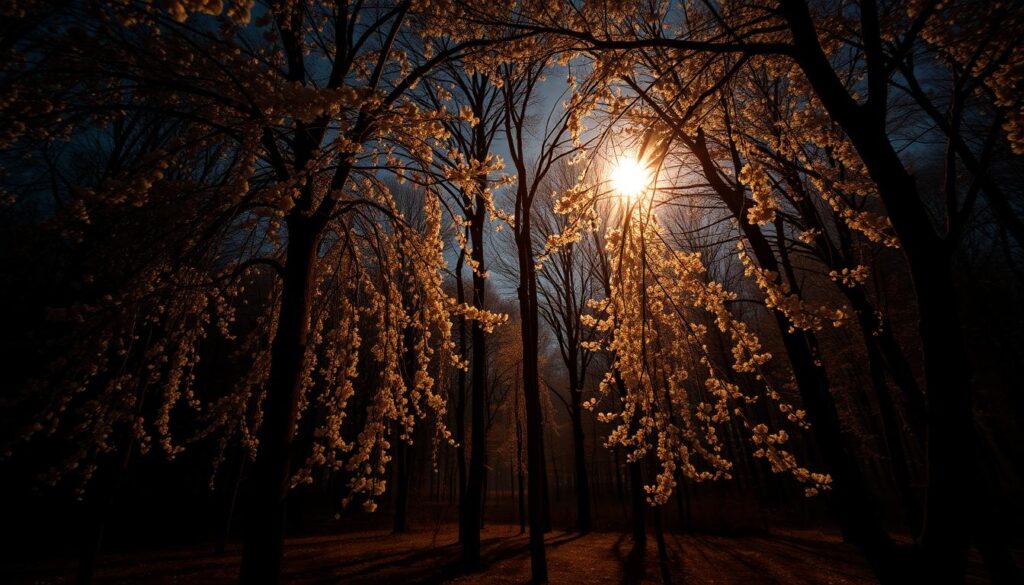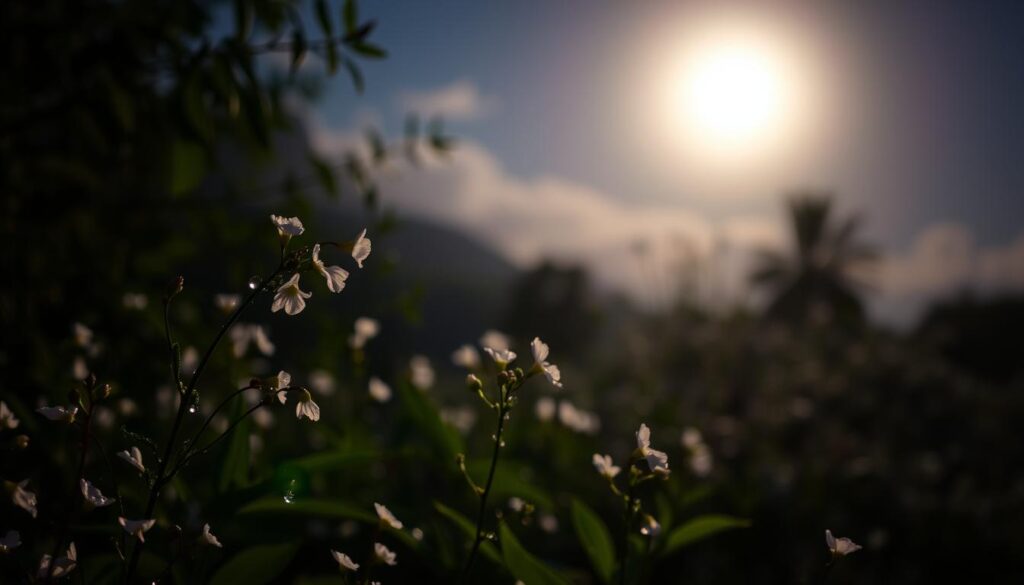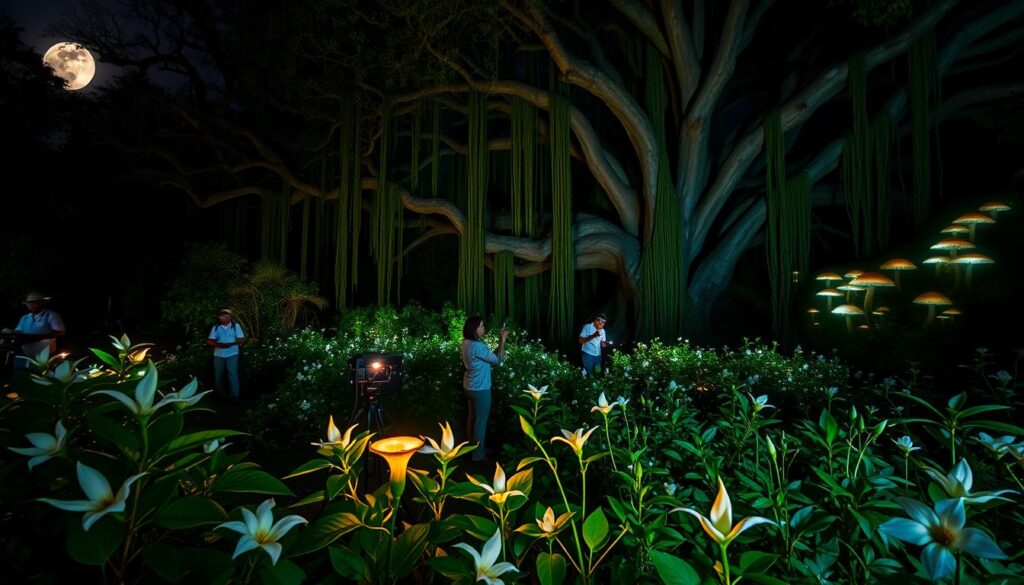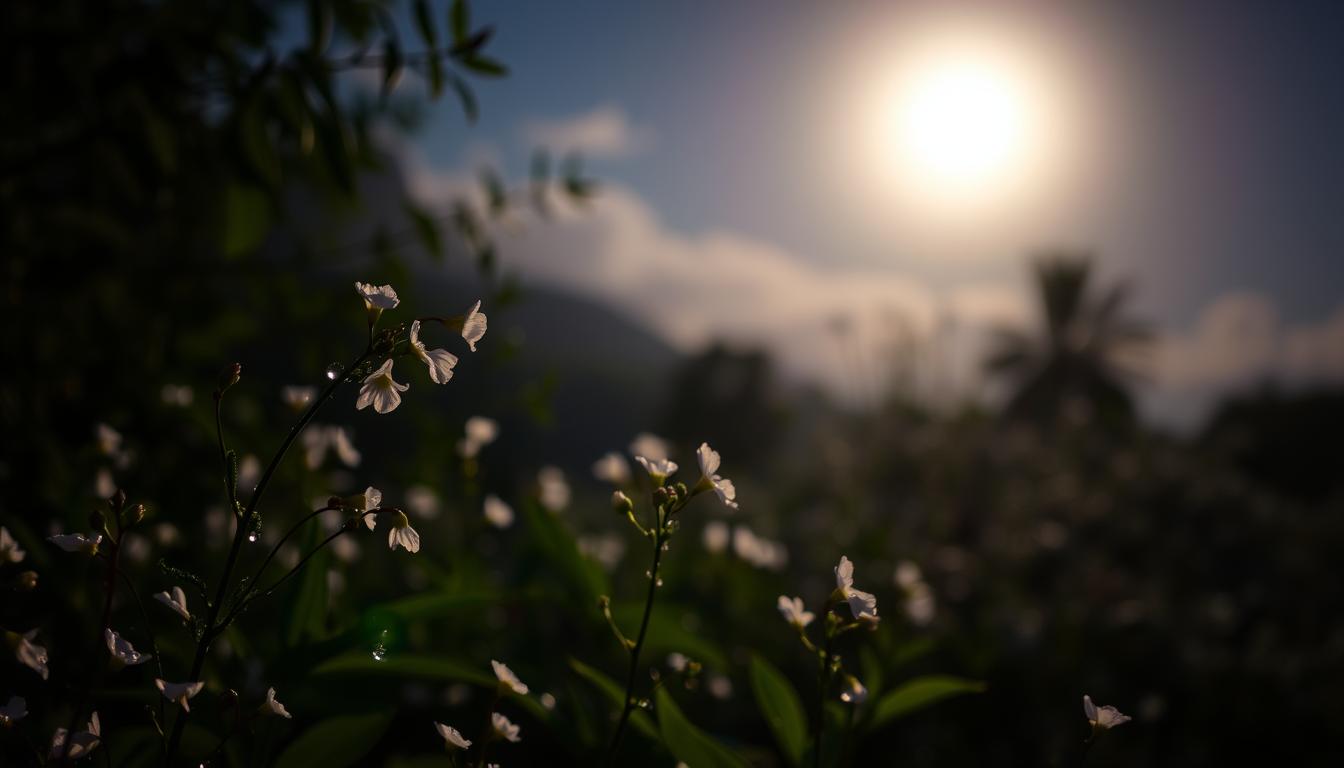Nocturnal blooming is a rare and magical sight. Trees bloom all at once under the night sky, creating a stunning nighttime garden. This natural wonder invites us to explore and understand the reasons behind this synchronized flowering.
In the United States, many people are fascinated by the beauty and mystery of nighttime blooming trees. Creating a nighttime garden with these trees is a great way to experience nocturnal blooming.

The uniqueness of nocturnal blooming lies in its ability to transform a ordinary landscape into a magical nighttime garden. This garden is filled with blooming trees that attract pollinators and delight spectators.
Introduction to Nocturnal Blooming
Nocturnal blooming has captivated many hearts, showing the wonders of nature. By understanding and appreciating nocturnal blooming, we can gain a deeper appreciation for the natural world. We also learn the importance of preserving it.
Key Takeaways
- Nocturnal blooming is a rare and enchanting display of trees that bloom at night
- Creating a nighttime garden with nocturnal blooming trees can be a great way to experience this phenomenon
- Nocturnal blooming transforms a ordinary landscape into a magical nighttime garden
- Nocturnal blooming attracts pollinators and delights spectators
- Understanding and appreciating nocturnal blooming can help us preserve the natural world
The Mysterious Phenomenon of Trees That Bloom All at Once at Night
Imagine walking through a forest at night, surrounded by the sweet fragrance of synchronized flowering trees. This natural wonder is both breathtaking and fascinating. It shows the unique traits of night blooming flowers.
The blooming of trees at night is a complex process. It involves environmental cues, genetic predispositions, and adaptations. These have evolved over time to help with pollination.
One key factor is how certain tree species respond to environmental cues. These cues include changes in temperature, humidity, and light. This allows them to bloom together, creating a stunning display of synchronized flowering.
Species like the Night-Blooming Cereus, the Moonflower, and the Evening Primrose are known for this. They bloom at night, attracting pollinators.
Understanding synchronized flowering gives us insights into plant and pollinator relationships. By studying this, we can appreciate the natural world more. We learn about the complex mechanisms behind night blooming flowers.
The Biology of Nighttime Blooming
The process of nighttime blooming in plants is complex and fascinating. It involves changes in hormone production, gene expression, and metabolic pathways. Nocturnal plants have evolved to thrive at night, with flowers that attract moths and bats.
Understanding the biology of blooming in these plants is key. Their flowers have special structures and produce lots of nectar. This attracts pollinators and helps with pollination.
Nocturnal plants bloom at night for many reasons. These include avoiding predators, competing for resources, and finding pollinators. Key factors include light, temperature, humidity, and pollinator availability.
- Light intensity and quality
- Temperature and humidity
- Pollinator availability and activity
In the case of nocturnal plants, the biology of blooming is about attracting pollinators. By studying nighttime blooming, we learn about these plants’ unique traits. This knowledge helps us protect them for the future.
Environmental Triggers for Nocturnal Flowering
Nocturnal flowering in trees is a complex process. It is influenced by various environmental triggers. The interaction between internal biological processes and external factors like temperature, humidity, and seasonal changes is key. Climate impact also plays a significant role, affecting the timing and duration of flowering.
Several factors contribute to the environmental triggers of nocturnal flowering, including:
- Temperature fluctuations
- Humidity levels
- Seasonal changes
- Moon phase influence
These factors can affect theenvironmental triggersthat prompt trees to bloom at night. This makes the process even more fascinating and complex.
Understanding the relationship between these environmental triggers and nocturnal flowering is important. It provides valuable insights into the biology of trees and the impact of climate impact on their behavior. By exploring these factors, we can gain a deeper appreciation for the intricate mechanisms that govern the natural world.
Best Locations to Witness Nighttime Blooming Trees
There are many places around the world where you can see nighttime blooming trees. These nighttime garden locations are special because they have plants that bloom at night. They create a magical atmosphere for everyone who visits.
Botanical gardens, national parks, and nature reserves are some of the best places to see these trees. They are known for their beauty and are loved by many.
When you plan to visit these places, think about the best times to see the blooming trees locations. Many places have guided tours or special events during the peak blooming times. This is a great way to see the beauty of these trees.
- Desert Botanical Garden in Phoenix, Arizona
- Fairchild Tropical Botanic Garden in Coral Gables, Florida
- United States Botanic Garden in Washington, D.C.
These locations are a chance to see the beauty of nighttime blooming trees. With a little planning, you can enjoy the magic of these nighttime garden locations. Whether it’s a local park or a place far away, there are many blooming trees locations to explore.
When to Plan Your Nighttime Bloom Viewing
To see the magic of nighttime blooms, plan your visit carefully. The peak blooming seasons for different plants vary. Knowing these times and the optimal viewing hours will enhance your experience.
The best time to see nighttime blooms is between 9 pm and 11 pm. This is when the moon is full and the weather is mild. But, remember the peak blooming seasons for the plants you want to see. Some bloom in early summer, others in late summer or early fall.
When planning your visit, think about the optimal viewing hours for your location. Some places have better hours because of moonlight or streetlights. Also, check the weather forecast. Rain or strong winds can ruin your view.
Weather Considerations
Weather greatly affects your nighttime bloom viewing. Clear skies and mild temperatures are best. Heavy rain or strong winds can make it hard to see the blooms. A full moon is also great for lighting.
Preparing for Your Adventure
To have a great time, be well-prepared. Bring binoculars, a flashlight, and comfy clothes. Also, think about the terrain and how easy it is to get there at night.
Photography Tips for Capturing Nocturnal Blossoms
To capture the beauty of nocturnal blossoms, you need the right tips. Using a tripod is key to avoid camera shake and blur. A lens with a wide aperture lets more light in, perfect for dark conditions. Knowing when nocturnal pollinators like moths and bats are active helps you time your shot.
Smartphone users can use apps for better nighttime photos. These apps offer manual focus, exposure control, and noise reduction. Patience and timing are crucial. Wait for the flowers to be fully bloomed and the light to be just right.

- Use a remote shutter release or the camera’s self-timer to avoid camera shake
- Shoot in raw format to capture more image data
- Experiment with different angles and compositions to add creativity to your photos
Follow these tips to take amazing photos of nocturnal blossoms. They will show off their beauty and uniqueness.
The Role of Pollinators in Night Blooming
Nocturnal pollinators like moths and bats are key to night blooming. They have special ways to move around in the dark. This helps plants spread their pollen.
Plants attract these pollinators with sweet nectar, strong scents, and moonlight. This makes it easier for them to find flowers.
The bond between pollinators and plants is amazing. Pollinators have big eyes and can hear well in the dark. Plants have evolved to be more fragrant and visible at night.
Primary Pollinators
- Moths: With their large eyes and sensitive antennae, moths are well-equipped to navigate and find flowers in the dark.
- Bats: Using echolocation, bats are able to locate and feed on nectar-rich flowers, transferring pollen in the process.
Nocturnal pollinators are vital for many plants to reproduce. Their unique ways of pollination are fascinating. By learning about them, we can better understand the complex world of plants and pollinators.
Cultural Significance of Night-Blooming Trees
Night-blooming trees hold a special place in many cultures. They are admired for their beauty, spiritual value, and healing properties. These trees are key to human culture, appearing in myths, legends, and traditional practices globally.
In many societies, these trees are seen as sacred. They are linked to spiritual growth and enlightenment. The fragrance of their flowers is thought to heal, and their beauty is believed to bring luck. They are also used in traditional medicine to treat different health issues.
Here are some ways night-blooming trees are culturally significant:
- Used in traditional ceremonies and rituals
- Linked to spiritual growth and enlightenment
- Used in traditional medicine
- Considered sacred and admired for their beauty
In many places, night-blooming trees symbolize love and romance. Their night-blooming flowers are often given as love gifts. The cultural importance of these trees shows their deep impact on human culture and society. Their beauty and significance continue to inspire and fascinate people worldwide.
Conservation and Protection of Night-Blooming Species
Night-blooming trees face many dangers, like losing their homes and the effects of climate change. This makes it vital to start conservation efforts to save them. Keeping their natural habitats safe is key to their survival.
Many groups are working hard to help night-blooming trees. They plant these trees in safe places and get people involved in their protection. This helps spread the word about why we need to save these trees and gets the community involved.

Current Threats to Night-Blooming Trees
- Habitat loss due to urbanization and deforestation
- Climate change, which alters the delicate balance of ecosystems
- Over-exploitation of night-blooming trees for their flowers and timber
Ways to Support Preservation
Everyone can help save night-blooming species. You can support groups that work on conservation efforts and preservation support. You can also plant these trees in your garden and tell others why they matter.
Together, we can make sure night-blooming trees keep their beauty for years to come. Let’s work as a team to protect them.
Creating Your Own Night-Blooming Garden
To create a night-blooming garden, pick suitable species for your area. This type of garden adds magic to your outdoor space. It offers a peaceful spot for relaxation and fun.
When picking plants, think about what each needs to grow well. For example, evening primrose likes sun and well-drained soil. Night-blooming jasmine prefers shade and moist soil. By choosing a mix of suitable species, your garden will be colorful and attract pollinators.
- Plant species at the same depth as in their pots, and water well after planting
- Keep up with regular care, like pruning, fertilizing, and controlling pests
- Find a spot with the right sunlight and soil for your plants
By picking the right suitable species and following these tips, you’ll enjoy your garden’s beauty and scent under the stars.
The Impact of Climate Change on Nocturnal Blooming Patterns
Climate change is deeply affecting our planet, especially the nocturnal blooming patterns of trees. Rising temperatures and changing rain patterns are messing with the night blooming timing. This can harm the plants, disrupt pollinators, and upset the whole ecosystem.
Several factors are causing these problems:
- Changes in temperature: Warmer weather can make plants bloom too early or too late, messing up the timing.
- Shifts in precipitation patterns: Changes in rain can make plants stressed, affecting their blooming.
- Seasonal timing: Climate change is also messing with the timing of seasons, like spring and winter. This can mess up plant growth and blooming.
The climate change impact on night blooming is complex. We need more research to understand it fully. But, it’s clear we must act to save these special ecosystems. By studying nocturnal blooming patterns and what affects them, we can help keep our world diverse and beautiful.
Conclusion: Embracing Nature’s Nighttime Symphony
As we conclude our journey into the world of nighttime blooming trees, we are amazed. Nature shows us a symphony of floral peace. These trees bloom at night, revealing the beauty and balance in our world.
We’ve seen how these trees bloom in sync and adapt to the dark. They are crucial for our ecosystems. The nighttime symphony they create is a treasure we must protect.
Let’s explore these wonders and support their conservation. By doing so, we enhance our lives and help our planet. Embracing these trees is key to preserving our world’s delicate balance.
FAQ
What is nocturnal blooming, and which tree species are known for this behavior?
Nocturnal blooming is when certain trees bloom at night. Trees like night-blooming jasmine, southern magnolia, and evening primrose do this.
What environmental factors trigger the synchronized nighttime blooming of trees?
Environmental factors like temperature, humidity, and moon phase trigger nighttime blooming. These factors work with the plants’ internal processes to make them bloom at night.
Where can I witness the beauty of nighttime blooming trees?
You can see nighttime blooming trees in many places around the world. Look for gardens, forests, and natural reserves known for this. You can also plan a trip to see these trees in bloom.
When is the best time to view the nighttime blooming of trees?
The best time to see nighttime blooming trees depends on the species. Generally, it’s in the evening and early morning. Weather, like moonlight, also affects the viewing.
What tips can I use to capture stunning photographs of nocturnal blossoms?
To take great photos of nighttime blooms, use tripods and the right lenses. Adjust your camera for low light. Knowing when pollinators are active helps too.
What is the role of pollinators in the nighttime blooming of trees?
Pollinators like moths and bats are key to nighttime blooming. They have special adaptations to find the flowers. This relationship is vital for the plants’ survival and reproduction.
How can I create my own night-blooming garden?
To make a night-blooming garden, choose the right plants for your area. Take care of them with good soil, water, and pest control. This will help your plants thrive.
How is climate change impacting the nocturnal blooming patterns of trees?
Climate change affects nighttime blooming trees in many ways. It can change temperature, rain, and when plants bloom. These changes can harm the plants and their pollinators, making them vulnerable.
